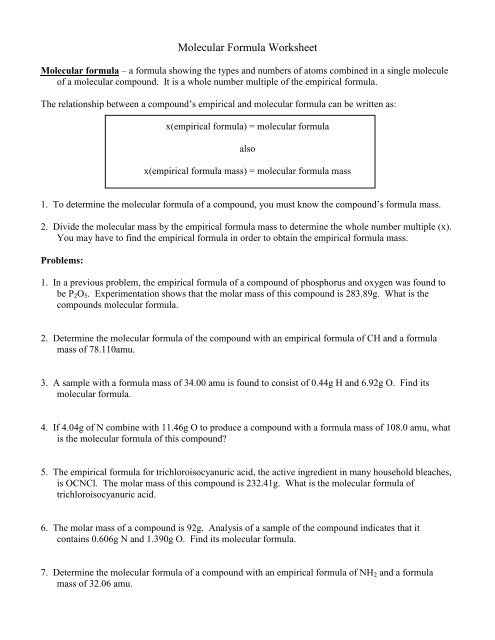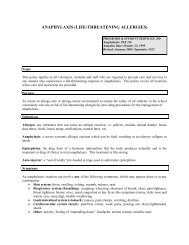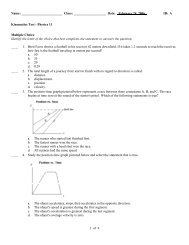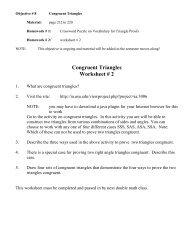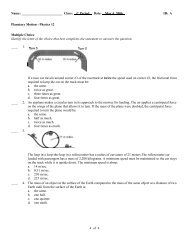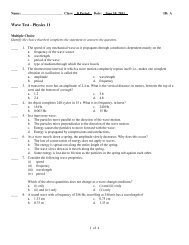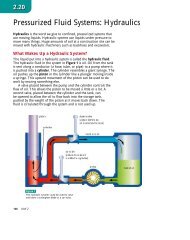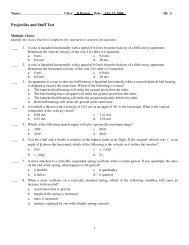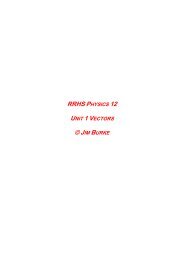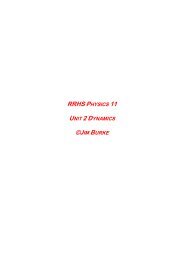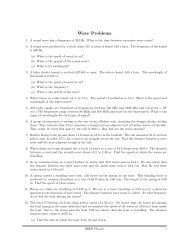Molecular Formula Worksheet
Molecular Formula Worksheet
Molecular Formula Worksheet
You also want an ePaper? Increase the reach of your titles
YUMPU automatically turns print PDFs into web optimized ePapers that Google loves.
<strong>Molecular</strong> <strong>Formula</strong> <strong>Worksheet</strong><strong>Molecular</strong> formula – a formula showing the types and numbers of atoms combined in a single moleculeof a molecular compound. It is a whole number multiple of the empirical formula.The relationship between a compound’s empirical and molecular formula can be written as:x(empirical formula) = molecular formulaalsox(empirical formula mass) = molecular formula mass1. To determine the molecular formula of a compound, you must know the compound’s formula mass.2. Divide the molecular mass by the empirical formula mass to determine the whole number multiple (x).You may have to find the empirical formula in order to obtain the empirical formula mass.Problems:1. In a previous problem, the empirical formula of a compound of phosphorus and oxygen was found tobe P 2 O 5 . Experimentation shows that the molar mass of this compound is 283.89g. What is thecompounds molecular formula.2. Determine the molecular formula of the compound with an empirical formula of CH and a formulamass of 78.110amu.3. A sample with a formula mass of 34.00 amu is found to consist of 0.44g H and 6.92g O. Find itsmolecular formula.4. If 4.04g of N combine with 11.46g O to produce a compound with a formula mass of 108.0 amu, whatis the molecular formula of this compound?5. The empirical formula for trichloroisocyanuric acid, the active ingredient in many household bleaches,is OCNCl. The molar mass of this compound is 232.41g. What is the molecular formula oftrichloroisocyanuric acid.6. The molar mass of a compound is 92g. Analysis of a sample of the compound indicates that itcontains 0.606g N and 1.390g O. Find its molecular formula.7. Determine the molecular formula of a compound with an empirical formula of NH 2 and a formulamass of 32.06 amu.
1. Empirical <strong>Formula</strong> = P 2 O 5 Empirical Mass = 2(31.0) + 5(16.0) = 142g<strong>Molecular</strong> Mass = 283.89g.2(P 2 O 5 ) = P 4 O 10283.8914222. Empirical <strong>Formula</strong> = CH Empirical Mass = 1(12.0) + 1(1.0) = 13g<strong>Molecular</strong> Mass = 78.110 amu6(CH) = C 6 H 678.1101363.0.44g H 1 mol H0.44= 0.44 mol H1.0g H 0.4336.92g O 1 mol O0.433= 0.433 mol O16.0g O 0.433HO= 1 H= 1 OEmpirical <strong>Formula</strong> = HOEmpirical Mass = 1(1.0) + 1(16.0) = 17g<strong>Molecular</strong> Mass = 34.00 amu2(HO) = H 2 O 234.001724.4.04 N 1 mol N0.289 = 1 N= 0.289 mol N14.0g N 0.28911.46g O 1 mol O0.7163= 0.7163 mol O= 2.5 O16.0g O 0.289X’s 2N 2 O 5
Empirical <strong>Formula</strong> = N 2 O 5 Empirical Mass = 2(14.0) + 5(16.0) = 108.0g<strong>Molecular</strong> Mass = 108.0 amu1(N 2 O 5 ) = N 2 O 5108.0108.0= 15. Empirical <strong>Formula</strong> = OCNCl Empirical Mass = 16.0+12.0+14.0+35.5 = 77.5g<strong>Molecular</strong> Mass = 232.41 amu3(OCNCl) = O 3 C 3 N 3 Cl 3232.4177.536.0.606g N 1 mol N0.0433= 0.0433 mol N14.0g N 0.04331.390g O 1 mol O0.08688= 0.08688 mol O16.0g O 0.0433= 1 N= 2 ONO 2Empirical <strong>Formula</strong> = NO 2 Empirical Mass = 1(14.0) + 2(16.0) = 46.0g<strong>Molecular</strong> Mass = 92 g1(NO 2 ) = N 2 O 49246= 27. Empirical <strong>Formula</strong> = NH 2 Empirical Mass = 1(14.0) + 2(1.0) = 16g<strong>Molecular</strong> Mass = 32.06 amu6(NH 2 ) = N 2 H 432.06162


